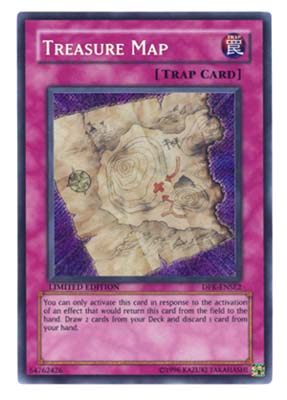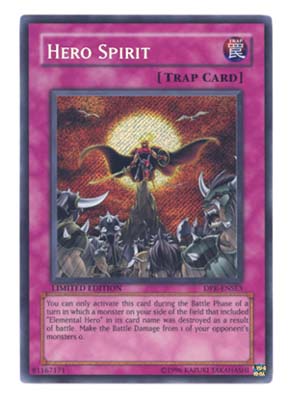Earlier this month, the popular Chazz and Jaden Duelist Packs were released in a special edition package with three brand-new cards. Each box contained a copy of either Blockman, Treasure Map, or the new Elemental Hero card Hero Spirit, for duelists to collect and use in their decks. This week, we’ll examine each of the new cards and cover all of the basics so you’ll have a solid handle on what they do.
He’s No Blockhead
 The hero of building blocks everywhere, Blockman’s effect allows you to build a wall of defending Block tokens. “By Tributing this face-up card, Special Summon in Defense Position a number of "Block Tokens" (Rock-Type/EARTH/Level 4/ATK 1000/DEF 1500) equal to the number of turns this card has been face-up on your side of the field. These tokens cannot declare an attack.”
The hero of building blocks everywhere, Blockman’s effect allows you to build a wall of defending Block tokens. “By Tributing this face-up card, Special Summon in Defense Position a number of "Block Tokens" (Rock-Type/EARTH/Level 4/ATK 1000/DEF 1500) equal to the number of turns this card has been face-up on your side of the field. These tokens cannot declare an attack.”
You can activate Blockman’s effect (which is an ignition effect) during your main phase. When it resolves, it will special summon one Block token onto your side of the field for each turn that it was face up on your side of the field. Determining how many Block tokens you get is important, so let’s take a look at the process.
Every turn that Blockman is face up on your side of the field counts toward its effect—even the turn in which you summon Blockman. This means that you can normal summon Blockman to the field and then immediately use its effect to get one Block token.
Let’s say that you normal summon Blockman. The count now stands at one. Your opponent begins his or her turn. The count now stands at two. During your opponent’s turn, he or she is unable to defeat your Blockman. You begin your next turn. The count now stands at three. At this point, you can tribute Blockman and special summon three Block tokens onto your side of the field. Not too shabby, right? By surviving just one of your opponent’s turns, you’ve taken one Blockman and turned it into three Block tokens. By surviving another one of your opponent’s turns, you could tribute Blockman and special summon five Block tokens.
What if you special summon Blockman during your opponent’s turn with a card like Giant Rat? The count would begin during your opponent’s turn, but since it is your opponent’s turn, you won’t be able to do anything with Blockman. Your opponent ends their turn, and yours begins. Now the count is two, so if you want, you can tribute Blockman in your main phase to special summon two Block tokens onto your side of the field.
The Block tokens special summoned by Blockman’s effect have only one restriction: they cannot attack. Any other purpose you have in mind for them is perfectly fine, including tributing them for a tribute summon! It’s much easier to play with high-level monsters when you have a friend like Blockman on your side.
When you plan to activate Blockman’s effect, however, you must have enough space on your side of the field for every Block token that will be special summoned. This is the same problem that Scapegoat has. Luckily, Blockman is a bit more flexible. Since it tributes itself to pay the cost for its effect, you’ll always have at least one free space available. It is the other remaining spaces that you’ll need to watch out for.
Buried Treasure?
 Treasure Map introduces a new draw mechanic with a very particular activation requirement. “You can only activate this card in response to the activation of an effect that would return this card from the field to the hand. Draw 2 cards from your Deck and discard 1 card from your hand.”
Treasure Map introduces a new draw mechanic with a very particular activation requirement. “You can only activate this card in response to the activation of an effect that would return this card from the field to the hand. Draw 2 cards from your Deck and discard 1 card from your hand.”
In order to activate Treasure Map, you need to wait for an effect to be activated that will return it to your hand. Giant Trunade is more than capable of fulfilling this requirement. When your opponent activates his or her Giant Trunade, you can—and should—activate Treasure Map in response. Treasure Map can only be activated in direct response to the card that will return it to your hand. If any other card effect is activated, you will lose your chance to activate Treasure Map.
Example 1: Treasure Found
Ivan enters his main phase and activates Giant Trunade. His opponent, Karen, has no response, so Ivan takes the opportunity to chain Treasure Map to his Giant Trunade.
Karen was unable to respond to Giant Trunade, which allowed Ivan to activate Treasure Map in direct response to Giant Trunade. He’s succeeded in getting its effect.
Example 2: Treasure Lost
Ivan enters his main phase and again activates Giant Trunade. This time, Karen responds by activating her set Waboku. At this point, Ivan wants to activate his Treasure Map, but he can’t, because activation must occur in direct response to Giant Trunade—and that’s no longer possible.
The strict activation demands of Treasure Map make it impossible to activate more then one in a chain, because the second Treasure Map would not be activating in response to a card with the right kind of effect. It’s important to keep this in mind if you plan on using multiple copies of Treasure Map in your deck.
Resolving Treasure Map is a far easier process. It works like a smaller version of Graceful Charity, only in this case, you draw two cards and then discard any one card from your hand for the effect. This makes Treasure Map a good fit with the Dark World monsters from Elemental Energy.
Who’s Next?
 Our final card for today is the trap card Hero Spirit. It reads, “You can only activate this card during the Battle Phase of a turn in which a monster on your side of the field that included "Elemental Hero" in its card name was destroyed as a result of battle. Make the Battle Damage from 1 of your opponent's monsters 0.”
Our final card for today is the trap card Hero Spirit. It reads, “You can only activate this card during the Battle Phase of a turn in which a monster on your side of the field that included "Elemental Hero" in its card name was destroyed as a result of battle. Make the Battle Damage from 1 of your opponent's monsters 0.”
While one Elemental Hero may have fallen, it can protect you from further harm in the process. Hero Spirit can be activated during the battle phase after you have lost an Elemental Hero in battle. When the proper trigger is reached, Hero Spirit steps into action and allows you to reduce the damage to your life points or your monsters.
When you activate Hero Spirit, you must select one monster on your opponent’s side of the field to target. The targeted monster will be affected by Hero Spirit when it performs an attack during that battle phase. By eliminating the monster’s ability to inflict damage to your life points or to destroy your monsters in battle, its abilities can be greatly hampered. Monsters like Don Zaloog and Kycoo the Ghost Destroyer won’t like this at all. It also means that monsters which can attack multiple times, like Chain Thrasher, will be out of luck for the entire turn.
It is important to note, however, that Hero Spirit won’t prevent effects like Mystic Swordsman LV2 or Drillroid from destroying your monsters. These effects have nothing to do with battle damage, so they will still be a concern for your monsters.
Until next time, send all comments to Curtis@metagame.com.